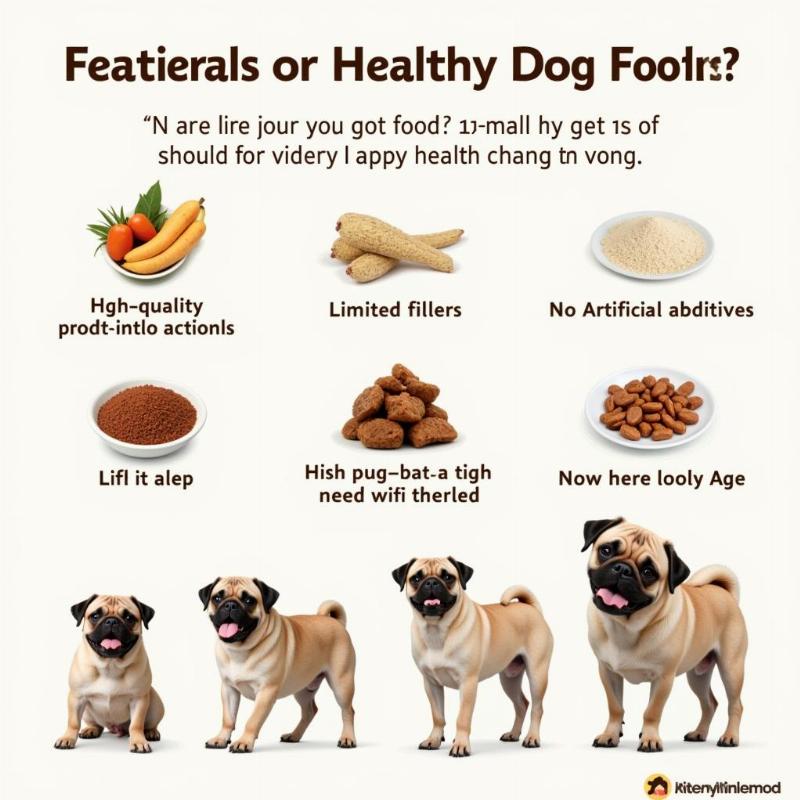Choosing the right food for your pug can be a daunting task, especially with the overwhelming number of options available in the US market. While pugs are known for their love of food, feeding them the wrong kind can lead to a variety of health issues. This article will delve into what constitutes the worst dog food for pugs, helping you navigate the pet food aisle and make informed decisions for your furry friend.
Decoding “Worst” Dog Food for Pugs
“Worst” dog food for pugs can encompass several aspects, from ingredients that trigger allergies to those lacking essential nutrients. Pugs, being a brachycephalic breed, have specific dietary needs that must be considered. Ignoring these can contribute to obesity, breathing difficulties, and skin problems. What might be a perfectly acceptable food for another breed could be detrimental to a pug’s health.
Common Culprits: Ingredients to Avoid
Certain ingredients are particularly problematic for pugs. Artificial colors, flavors, and preservatives top the list. These additives offer no nutritional value and can exacerbate skin allergies, a common issue in pugs. Fillers like corn, wheat, and soy provide minimal nutrition and can lead to weight gain, further complicating their breathing issues. By-products, often vague and poorly defined, should also be avoided. Opt for foods with whole, identifiable meat sources as the primary ingredient.
The Perils of Low-Quality Protein
While protein is crucial for muscle development and overall health, the source of protein matters. Low-quality protein sources, often found in cheaper dog foods, are difficult for pugs to digest and can strain their kidneys. Look for dog foods that specify the type of meat, such as chicken, beef, or lamb, rather than generic terms like “meat meal.”
Addressing Pug-Specific Health Concerns
Pugs are prone to certain health issues, and their diet plays a vital role in managing these conditions. Obesity is a significant concern, and foods high in fat and fillers can exacerbate this problem. Skin allergies, often triggered by certain ingredients, can cause itching, discomfort, and secondary infections. Breathing difficulties, common in brachycephalic breeds, can be worsened by obesity. Choosing a food specifically formulated for pugs, or at least for small breeds with sensitive stomachs, can help mitigate these risks.
Recognizing the Signs of a Poor Diet
How can you tell if your pug’s current food isn’t cutting it? Look for signs like dull coat, excessive shedding, itchy skin, digestive issues (gas, vomiting, diarrhea), and weight fluctuations. If you notice any of these symptoms, consult your veterinarian and consider switching to a higher quality food.
Choosing the Right Food: A Guide for Pug Owners
Selecting the best food for your pug requires careful consideration. Look for foods with high-quality protein sources, limited fillers, and no artificial additives. Consider your pug’s age, activity level, and any specific health concerns. Don’t be swayed by marketing gimmicks; focus on the ingredient list and nutritional information.
 Choosing the Right Dog Food for Pugs
Choosing the Right Dog Food for Pugs
Conclusion
Choosing the worst dog food for your pug can have serious consequences for their health and well-being. By understanding the ingredients to avoid and focusing on a balanced, nutritious diet, you can help your pug live a longer, healthier, and happier life. Remember, investing in high-quality dog food is an investment in your pug’s future.
FAQ
-
What are some common signs of food allergies in pugs? Itchy skin, excessive scratching, ear infections, and gastrointestinal upset.
-
Is grain-free dog food always better for pugs? Not necessarily. Some pugs thrive on grain-free diets, while others may require grains for optimal digestion. Consult your veterinarian.
-
How much should I feed my pug? Feeding guidelines vary depending on age, activity level, and specific food. Check the label and consult your vet for personalized recommendations.
-
Can I give my pug human food? Some human foods are safe for pugs in moderation, while others are toxic. Always research before feeding your pug anything other than their regular dog food.
-
What are some good protein sources for pugs? Chicken, beef, lamb, turkey, and fish are all good protein sources for pugs.
-
Should I feed my pug wet or dry food? Both wet and dry foods have their pros and cons. Choose the option that best suits your pug’s individual needs and preferences.
-
How often should I change my pug’s food? If you need to change your pug’s food, do so gradually to avoid digestive upset.
Beautdogs.us is your premier source for all things dog-related in the US. We offer expert advice on dog breeds, care, and product recommendations. Whether you’re a new pug owner or a seasoned pro, Beautdogs.us is your trusted resource for comprehensive and engaging information. Contact us today for personalized guidance! Email: [email protected], Phone: +1 501-555-7529. Let Beautdogs.us help you give your pug the best life possible!